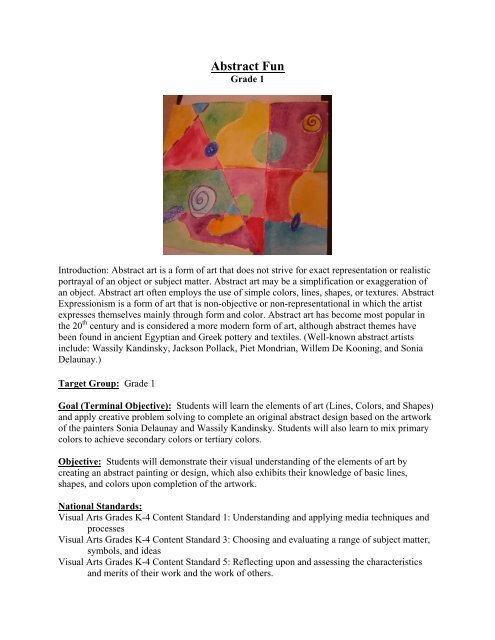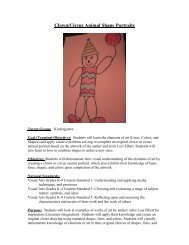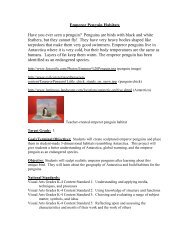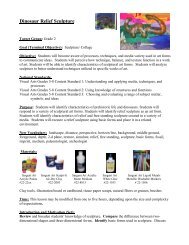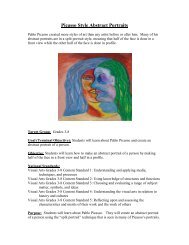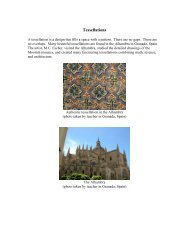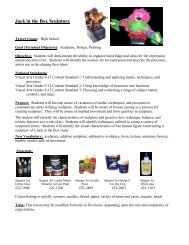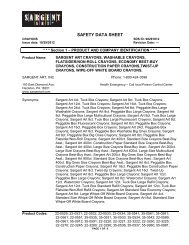Abstract Fun - Sargent Art
Abstract Fun - Sargent Art
Abstract Fun - Sargent Art
You also want an ePaper? Increase the reach of your titles
YUMPU automatically turns print PDFs into web optimized ePapers that Google loves.
<strong>Abstract</strong> <strong>Fun</strong><br />
Grade 1<br />
Introduction: <strong>Abstract</strong> art is a form of art that does not strive for exact representation or realistic<br />
portrayal of an object or subject matter. <strong>Abstract</strong> art may be a simplification or exaggeration of<br />
an object. <strong>Abstract</strong> art often employs the use of simple colors, lines, shapes, or textures. <strong>Abstract</strong><br />
Expressionism is a form of art that is non-objective or non-representational in which the artist<br />
expresses themselves mainly through form and color. <strong>Abstract</strong> art has become most popular in<br />
the 20 th century and is considered a more modern form of art, although abstract themes have<br />
been found in ancient Egyptian and Greek pottery and textiles. (Well-known abstract artists<br />
include: Wassily Kandinsky, Jackson Pollack, Piet Mondrian, Willem De Kooning, and Sonia<br />
Delaunay.)<br />
Target Group: Grade 1<br />
Goal (Terminal Objective): Students will learn the elements of art (Lines, Colors, and Shapes)<br />
and apply creative problem solving to complete an original abstract design based on the artwork<br />
of the painters Sonia Delaunay and Wassily Kandinsky. Students will also learn to mix primary<br />
colors to achieve secondary colors or tertiary colors.<br />
Objective: Students will demonstrate their visual understanding of the elements of art by<br />
creating an abstract painting or design, which also exhibits their knowledge of basic lines,<br />
shapes, and colors upon completion of the artwork.<br />
National Standards:<br />
Visual <strong>Art</strong>s Grades K-4 Content Standard 1: Understanding and applying media techniques and<br />
processes<br />
Visual <strong>Art</strong>s Grades K-4 Content Standard 3: Choosing and evaluating a range of subject matter,<br />
symbols, and ideas<br />
Visual <strong>Art</strong>s Grades K-4 Content Standard 5: Reflecting upon and assessing the characteristics<br />
and merits of their work and the work of others.
Purpose: Students will look at examples of works of art by artist Wassily Kandinsky and Sonia<br />
Delaunay. Students will apply their knowledge and create an original abstract painting using<br />
repeated shapes, lines, and colors. Students will visually demonstrate knowledge of elements of<br />
art in their original choices of shapes, lines, and colors to complete the composition. Students<br />
will identify and use types of lines and shapes. (Math Integration)<br />
New Vocabulary: abstract, color, line, shape, dot, circle, dotted line, spiral, angled line, kidneyshaped,<br />
primary colors, secondary colors, tertiary colors, Kandinsky, Sonia Delaunay<br />
Materials:<br />
White or manila drawing paper (example is 9”x 12”), <strong>Sargent</strong> <strong>Art</strong> Crayons 24 count (#22-0534),<br />
<strong>Sargent</strong> <strong>Art</strong> “Rainbow” brush set (#56-6012), <strong>Sargent</strong> <strong>Art</strong> Watercolor 16 ct. paint set (#66-8824),<br />
and the following <strong>Sargent</strong> <strong>Art</strong> supplies:<br />
#56-6012 #22-0534 #22-8426<br />
Rainbow Brush Set <strong>Sargent</strong> Crayons <strong>Sargent</strong> Watercolors<br />
16-color set with brush<br />
Time: approximately 1-2 class periods<br />
Instruction and Motivation (Set):<br />
1. Have students name the basic lines and shapes (straight, curved, zigzag, dotted, rectangle,<br />
circle, triangle, etc.) and find them in Kandinsky’s or Delaunay’s artwork. Students will<br />
be guided to discover the colors, lines, and shapes in Kandinsky’s artwork. The teacher<br />
will define the primary colors, secondary, and tertiary colors using a color wheel chart.<br />
2. Teacher will show examples of student completed abstract paintings.<br />
3. Students will view a chart with the circle, dot, and line families delineated.<br />
4. The teacher will demonstrate how to mix colors to make new ones. (Mixing primaries<br />
and secondaries to obtain tertiaries.)
Student example grade 1<br />
Instruction:<br />
1. Begin by having students label the back of their paper with their names.<br />
2. Using a crayon, students will draw four straight lines that cross each other and go to the edge<br />
of the paper. Lines may be diagonal or straight.
Students will put crayon back in bowl.<br />
3. Students will then pick up a different color crayon and draw 2 circles that touch a line. They<br />
can be oval, circles, kidney-shaped or ellipse-shaped. They are to be empty and any size<br />
anywhere on the page. They will replace that color crayon.<br />
4. Next, students will draw 3 dots -- any size or shape (like the circles) with a different color<br />
crayon. They should color them in solidly. Then replace that crayon.<br />
5. Choosing another crayon color, students will place their crayon on the dot and draw a curvy<br />
line going off the page. It will look like a balloon. Do this twice. Replace this color crayon in the<br />
bowl.
6. Now the student may pick up a final color and add two or three things on their own such<br />
as: a zigzag, angled line, a spiral, a dotted line, a shape like circle or dot, etc.<br />
7. Students will then wet their paints with clear water by dropping a drop of water into each<br />
color first. Then they will paint in the shapes, repeating colors in different sections of the<br />
painting but not touching.<br />
8. Students should mix colors to make new ones, such as tertiaries and work on refining<br />
painting skills. All white areas should be covered with paint.<br />
Activities:<br />
(1) Guided Practice:<br />
a. Students view and discuss examples of artwork representing a form of abstraction.<br />
b. Students discuss the art elements that include types of lines, shapes, and colors.<br />
(Circles are empty shapes, dots are filled in, and lines may be curved, straight or angled.)<br />
c. Students will be given step-by-step directions to use crayon to create the abstract<br />
outlines or “blueprint.”<br />
d. Students demonstrate their technical ability to paint colors on evenly, to mix colors<br />
successfully, and to fill the space to achieve an original abstract painting.
(2) Independent Practice and Check for Understanding:<br />
a. Teacher will circulate and help students with design questions. Teacher may make<br />
suggestions to students to mix colors or to add art elements.<br />
b. Teacher may offer individual help with painting smoothly and evenly and where to<br />
locate or add repeated colors.<br />
(3) Closure: Teacher leads students in a discussion of what art elements (shapes, colors, or lines)<br />
each student used or colors mixed to create their abstract painting. Teacher will inquire what is<br />
an “abstract?”<br />
Evaluation:<br />
Level One -- The finished design very successfully demonstrates the student’s understanding of<br />
the elements of art and abstraction. The student has shown strong technical skills in their use of<br />
painting, drawing, and use of color. The student has shown a high level of creativity in<br />
completing the motif with original detail. Craftsmanship is outstanding.<br />
Level Two -- The finished design demonstrates the student’s understanding of the elements of art<br />
and abstraction. The student has shown good technical skills in his/her use of painting, drawing,<br />
and use of color. The student has shown creativity in completing the motif with original detail.<br />
Craftsmanship is good.<br />
Level Three -- The finished design demonstrates effort on the student’s part to show his/her<br />
understanding of the elements of art. The student has shown little technical skill in his/her use of<br />
painting, drawing, or use of color. The student has shown limited creativity in completing the<br />
motif with any detail. Craftsmanship is minimal.<br />
Level Four -- The finished design lacks evidence of the student’s understanding of elements of<br />
art and abstraction. There is no technical skill shown in his/ her use of painting/drawing or use<br />
of color. The student’s final project lacks creativity and craftsmanship.<br />
Extension: This project can be greatly simplified for younger students, or vice versa for older,<br />
more advanced students. It also fits in very well within a unit of color theory and understanding<br />
balance or the design principles. Oil pastels or watercolor crayons could be used for a different<br />
visual effect. In addition, students could be asked to use just one shape.<br />
Resources:<br />
http://www.artcyclopedia.com/artists/kandinsky_wassily.html<br />
http://www.insecula.com/us/oeuvre/O0016692.html<br />
http://www.monart.com/<br />
Mona Brookes book, “Drawing with Children” 1986, revised 1995.<br />
BY RISELLE ABRAMS<br />
<strong>Art</strong> Consultant<br />
_____________________________________________________________________________<br />
www.sargentart.com 01/27/2008


